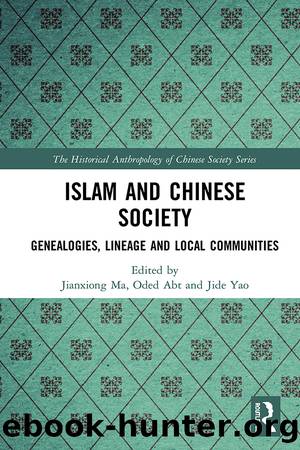Islam and Chinese Society by Unknown

Author:Unknown
Language: eng
Format: epub
Publisher: Taylor & Francis Group
Published: 2020-04-15T00:00:00+00:00
The Compilation of the Ding Family Genealogy
The compilation of a genealogy is the expression of the collective action of a lineage and defines communal identity. Therefore, this study begins by examining the origins of the Genealogy of the Taozhou Ding Lineage. To understand the history of this document, it is necessary to begin with the Hui rebellion in the 1860s.
The Hui rebellion lasting from 1863 to 1867 made momentous impact on Taozhou society. During that time, some Hui people in Taozhou and Hezhou fought against the local gentryâs militia (mintuan) and the Qing army known as the Green Standard (lüying). They fought over control of the forts in different parts of the prefecture. The gentry militias and armed village volunteers caused immense damage to local society, as the local gazetteer reported:
In 1862, the Hui made use of the opportunity created by the Nian rebellions in central China and started to rebel. On the 11th day of the second month in 1863, the Hui in Taozhou followed suit ⦠On the 1st day of the eleventh month [1865], the militia leader He Jianwei took control of the Zhanqi Fort and killed almost all the people there. Therefore, the people invited the Hui back to drive out the militias. On the 13th day of the fifth month in 1866, the Hui took control of the Mill Valley Fort. In autumn, General Fan Ming collected the scattered volunteers still in the Di[dao]-He[zhou] area and defeated the Hui in the southern part of the city. The Taozhou Hui then fled to Hezhou, and the uprising thus came to an end.16
These records show that the Hui uprising at Taozhou affected the areas to its east and south. In 1864, Hui from Hezhou entered Taozhou and took control of the Tibetan Yucheng Buddhist monastery. In 1865, gentry-led militias and village volunteers advanced from the west of Taozhou and attacked the Zhuoxun Fort in Zhuoni prefecture. Moving east from Taozhou Old City, they made their way toward the New City administrative center, controlling the Mill Valley Fort west of the New City. The discipline of the village volunteers and militias was lax, for while fighting against the Hui, they occupied the forts and treated the people cruelly, carrying out massacres in the forts once occupied by the Hui and âkilling almost all the common people.â As a result, the ordinary people living in the southeast section of Taozhou sided with the Hui and âinvited the Hui to drive out the volunteers.â17 It was only in the autumn of 1867 that General Fan Ming managed to collect and organize the scattered volunteers in Didao and Hezhou prefectures and drove the Taozhou Hui to Hezhou, thus ending the Taozhou Hui uprising.
During these conflicts, people of the Ding surname defended the Old City and when peace was restored helped to rebuild it. As the Genealogy of the Taozhou Ding Lineage recorded of ninth-generation ancestor, Xingyuan:
Our ancestor Xingyuan was the father of Yisan. All through his life, he conducted business with righteousness and treated people with courtesy.
Download
This site does not store any files on its server. We only index and link to content provided by other sites. Please contact the content providers to delete copyright contents if any and email us, we'll remove relevant links or contents immediately.
| Africa | Americas |
| Arctic & Antarctica | Asia |
| Australia & Oceania | Europe |
| Middle East | Russia |
| United States | World |
| Ancient Civilizations | Military |
| Historical Study & Educational Resources |
The Battle of Mogadishu by Matt Eversmann & Dan Schilling(725)
The Confidence Men by Margalit Fox(675)
The Spymaster of Baghdad by Margaret Coker(645)
A History of the Muslim World since 1260: The Making of a Global Community by Vernon O. Egger(644)
Jack the Ripper and the East End by Peter Ackroyd(613)
Empire of Fear: Inside the Islamic State by Andrew Hosken(591)
The Afghanistan File by Prince Turki AlFaisal Al Saud(588)
The Crimean War by Winfried Baumgart(581)
Islam At The Gates: How Christendom Defeated the Ottoman Turks by Diane Moczar(576)
The Jerusalem Diamond by Noah Gordon(569)
Akhenaten by Dominic Montserrat(567)
A Concise History of Greece (Cambridge Concise Histories) by Richard Clogg(558)
Beirut 2020 by Charif Majdalani(556)
The History of Jihad by Robert Spencer(552)
Enemy in the East by Rolf-Dieter Müller(538)
Israel: Ancient Kingdom or Late Invention? by Daniel I. Block(532)
The Privatization of Israeli Security by Shir Hever(529)
The Nine Lives of Pakistan by Declan WALSH(524)
Destroying a Nation: The Civil War in Syria by Nikolaos van Dam(518)
